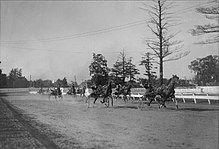Harness racing
In Europe, and less frequently in Australia and New Zealand, races with jockeys riding directly on saddled trotters (trot monté in French) are also conducted.The light cold-blooded Coldblood trotters and Finnhorses race separately in Finland, Norway and Sweden.[3] From Messenger came a great-grandson, Hambletonian 10 (1849–1876), a horse who gained a wide following for his racing prowess and successful offspring.[1] The lineage of virtually all North American Standardbred race horses can be traced from four of Hambletonian 10's sons.Foiled Again retired on January 1, 2019, but the then 15-year-old gelding left an indelible mark in harness racing annals.One of the reasons pacers are less likely to break stride is that they often wear hobbles (straps connecting the legs on each of the horse's sides).The driver (not a "jockey", as in thoroughbred racing) carries a light whip chiefly used to signal the horse by tapping and to make noise by striking the sulky shaft.Other important harness racing arenas in Scandinavia are Åby outside Gothenburg, Mantorp, Axevalla, Bergsåker, Boden (almost at the polar circle) and Charlottenlund in Danish capital Copenhagen.This is explained by the fact that the outer track is close to 15 meters longer per lap, front running is always heavier compared with just follow behind (just like in cycling).On the other hand, if an opening in the outer track appears close to the finish line, such a horse has had "an easy ride" with much strength left to give.The huge popularity of trot betting in Sweden "spills over" to the neighboring Norway (11 racing tracks), Finland (43) and Denmark (9).[11][12] Trotting sport and betting also exist in Austria, Belgium, Germany, Hungary, Serbia, Italy, the Netherlands, Malta, Russia, United Kingdom and Estonia.North American harness horses earn a "mark" (a record), which is their fastest winning time at that distance.This "hub rail" was replaced with a row of short pylons (usually of a flexible material), which mark the inside boundary of the course.This generally means that with the smaller tracks a "three-wide train" starts as the field gets the bell at signal their final lap.[13] Some harness racing clubs have been granted additional funds for the installation of the AVA computerised mobile barriers.[14] In Australia and New Zealand, harness racing is conducted both on smaller rural tracks and at major city venues, creating the opportunity for even the hobby-trainer to make it into the big-time if they have an exceptional horse.The premier events can now have prizemoney exceeding AUD 1 million and recent upgrades to some venues has created world-class facilities for harness racing.For the younger horses there are series that stem from yearling sales including the Australian Pacing Gold and an Australasian Breeders Crown.The Harness Jewels raceday (the end-of-year championships for two-, three- and four-year-olds) takes place in late May/early June The major open races in Australia and New Zealand are brought together in an Australasian Pacers Grand Circuit.The leading harness racing nations in Europe are France, Italy and Sweden, and the sport is fairly popular in most northern European countries.The Prix d'Amérique at Vincennes hippodrome near Paris is widely considered to be the most prestigious event of the European racing year.A yearly Grand Circuit tour for the top trotters includes a number of prestigious European races.All notable racing nations also host their own highly regarded premier events for young horses.Monté (races to saddle) have recently been introduced in larger scale in Sweden and Norway, to increase interest and recruitment to the sport.




governing bodyMixed-sexhorse harnesshorse racingStandardbredFrench TrottersRussian TrottersOrlov TrottersRussiaColdblood trottersFinnhorsesFinlandNorwaySwedenStandardbredsstud bookThoroughbredsMessengerJohn Jacob AstorHambletonian 10I'm ThemightyquinnhobblesVincennesstarting gateEuropeanAustralianNew ZealandPrix d'AmériqueVincennes hippodromeHarness racing in SwedenHarness racing in FinlandSeinäjokiJägersroBro ParkSolvallaStockholmElitloppetSwedish Trotting DerbyMalmöHugo Åbergs MemorialGothenburgMantorppolar circleCharlottenlundCopenhagenDenmarkTraveller communityAustriaBelgiumGermanyHungarySerbiaNetherlandsUnited KingdomEstoniaSalem Township, MichiganHarness racing in AustraliaHarness racing in New ZealandNorth AmericanmetricTasmanGlobe Derby ParkMenangle Park PacewayMelton Entertainment ParkAlexandra ParkAddington RacewayHambletonianLittle Brown JugBreeders CrownTrotting Triple CrownPacing Triple CrownNorth America CupCanadian Pacing DerbyMaple Leaf TrotGrand CircuitMeadowlands RacetrackEast Rutherford, New JerseyYonkers RacewayYonkers, New YorkThe Red MileLexington, KentuckyMohawk ParkCampbellville, OntarioHarness Horse of the YearInter DominionAustraliaMiracle Mile PaceA.G. Hunter CupVictoria CupAustralian Pacing ChampionshipVictoria DerbyAustralian DerbyAustralasian Breeders CrownNew Zealand CupAuckland CupNew Zealand Free For AllNoel J Taylor Memorial MileNew Zealand Messenger ChampionshipNew Zealand DerbyGreat Northern DerbyDominion HandicapRowe CupAustralasian Pacers Grand CircuitGran Premio Lotteria di AgnanoNaplesÄlgen StoltaCanadian Horse Racing Hall of FameChariot racingHarness Racing Museum & Hall of FameList of films about horse racingWisconsin Public TelevisionEquestrian sportsEquestrianismEquitationOlympicDressageEventingShow jumpingCombined drivingEnduranceHorseballReiningTent peggingVaultingPara-equestrianFlat racing
